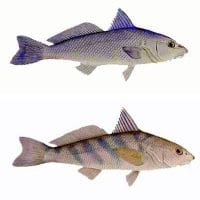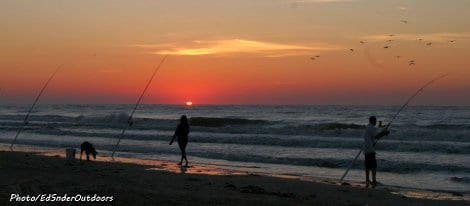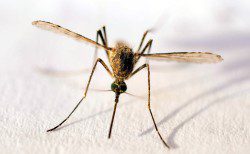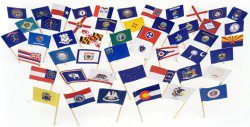 By Ed Snyder/Outdoors
By Ed Snyder/Outdoors
Fishing reports advised the whiting were biting in the surf along Rollover’s beachfront, and with nothing much happening anywhere else, a trip was quickly planned for some hopefully active surf fishing action that would put a few whiting on the fish fry menu. Arriving on Rollover Pass beach the following morning, I was treated to an amazing sunrise and pleasantly surprised to find the surf flat. Driving down the beach to a yellow beach house (a favored surf fishing area), I positioned my vehicle, hammered my rod holders in the sand, set out my beach chair, and made my first cast into the surf. Then, even before I could set my surf-rig into the rod holder my fishing rod suddenly arched, validating the fishing report as a chunky 14-inch whiting became the first, of many, that would fill the bottom of my cooler.
After settling back in my surf-chair with a mug of hot coffee wafting it’s steamy, french roast aroma, my eyes began taking in the coastal vista of diving sea birds and rippling surf…“Life is good!”

Gulf Whiting (top) and Atlantic Whiting
Found along the Atlantic coast as far north as New York and as far south as Argentina, the southern kingfish are also found throughout the Gulf of Mexico with heavy concentrations along the Texas Gulf Coast, with the gulf kingfish primarily a gulf species. Mostly found in the surf, whiting prefer water over the sandy or muddy bottoms found along the surf or around gulf piers, jetties, rock groins, old pilings, or boat basins. Shell banks with clay bottoms are great fishing areas for whiting who like to feed within the clutter of seashells.
Both species spawn anywhere from April through August, with females scattering their eggs in open waters, where, after hatching, the young larvae are carried by currents to inshore waters where the young survive for months by seeking food and protection from predators. During this period they are heavily predated by redfish, speckled trout, jack crevalle, shark, and just about every surf species that feeds on other fish, including adult whiting.

A whiting rig can sport multiple hooks for multiple catches
One little unknown fact about fishing for whiting is that they are an excellent night fishing species and will school up in heavy concentrations near the surf edges during the night. This is also a good time for catching the larger “bull” whiting. The best places for night-fishing the whiting would be near piers, rock jetties, or gulf cuts that have lit up areas near the surf-line.

An angler's meal of beer batter whiting, country style beans, and cottage fries
So when those redfish, speckled trout, flounder, and other preferred surf residents aren’t cooperating for that family fish fry, target the lesser known, but much appreciated whiting for a day of surf fishing fun for an evenings meal that will definitely satisfy your seafood cravings.
Texas saltwater fishing records list the Southern Kingfish at 3.62 lbs and the Gulf Kingfish at 2.38 lbs. This report caught me by surprise since I had caught a 4.5 lb specimen while fishing San Luis pass during a long ago February fishing trip. But that was my loss. The average size for surf whiting will mostly be within the half-to-one pound range, with some “bull” whiting going 2 pounds or better. Although smallish by anyone’s surf-fishing standards, the whiting do however have thick bodies which provide some excellent fillets.

Anglers with Atlantic and Gulf whiting...and a cooler of whiting for these surf anglers (photos by Ed Snyder/Outdoors)
Presently, Texas Parks & Wildlife lists unlimited size or creel limits for whiting. So you can catch and keep as many as you feel you want to clean and eat. Having soft flesh, the whiting don’t really keep well in the freezer. But one way to preserve them for future fish fries would be to keep 6 fillets per zip-bag with a teaspoon of lemon juice. The lemon juice will help to keep the flesh firm and fresh for at least three months. NOTE: When catching and keeping whiting, or any saltwater species, ALWAYS store in coolers of ice to keep them fresh. If the fish aren’t chilled they will stress, giving off ammonia like gases that will spoil your catch, often giving them a gamey taste.

Surfing for whiting
Often times, during our short, but chilly Texas winters, we are often blessed (thanks to the gulf) with some nice warm-up trends mixed betwixt those blue-bird cold fronts. It is at these times that you’ll see anglers shedding their wintry woes by grabbing their fishing gear and heading to their favorite surf-fishing areas. Whiting will be the main item of interests on their fishing agenda, but when these whiting concentrate along the surf-line they often attract other species such as redfish or black drum. So as your relaxing trip to the Texas coast may provide some easy fishing, it could also produce some “Toe to Toe” activity with those predator fish that will often weigh 20 lbs or better. Just figure this as a bonus catch IF you can reel that critter in on light tackle that is.
Winter fishing on the Texas Gulf Coast, especially on Bolivar Peninsula beaches, can provide needed breaks from those wintry doldrums, and in doing so, will provide an early season fish fry for you as well. Try it, you’ll like it!

This article sponsored by www.fishingworld.com, www.crystalbeachlocalnews.com, Face Book-Miss Nancy’s Bait Shop, Ed Snyder/Outdoors, and The Beach Triton.
Ed Snyder/Outdoors
Bolivar Peninsula, TX.
February 4, 2014

 Posted in
Posted in 
























